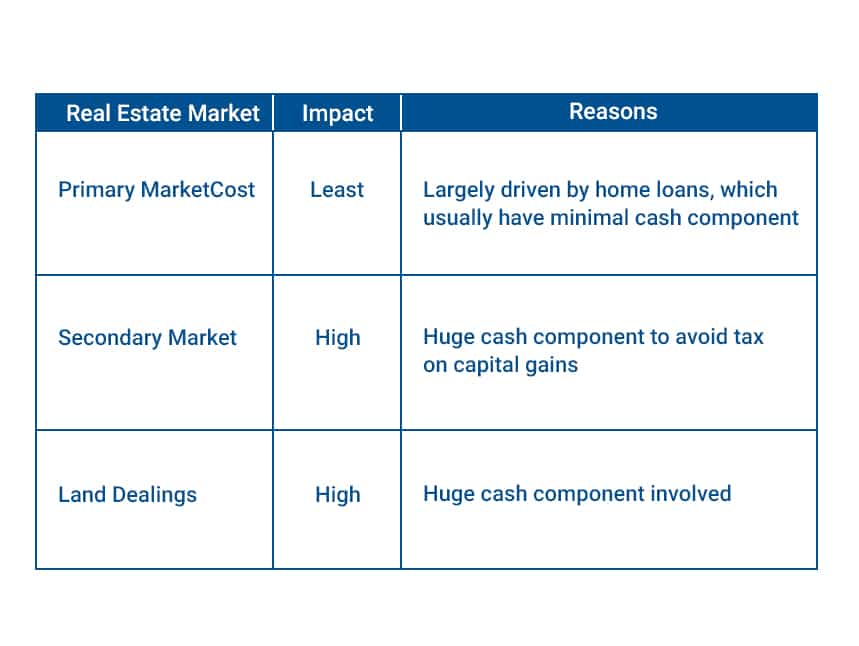“To break the grip of corruption and black money, we have decided that the five hundred rupee and thousand rupee currency notes presently in use will no longer be legal tender from midnight tonight,” said Prime Minister Narendra Modi in a surprise address to citizens on November 8th, 2016.
India has traditionally been a cash-dominated economy where the majority of transactions are still carried out in cash. When the surgical strike against the black money rendered 86% of the currency in circulation useless, there was a palpable sense of chaos in the country. The NIFTY Realty Index fell by almost 12% the very next day.
Though the well-intended move was to combat corruption in the short-term, the government’s larger vision was to engineer a colossal transformation in the way transactions were carried out in the country.
The biggest-ever demonetisation exercise led to long queues at banks and ATMs. The banking sector benefited with stocks surging up to 12% with increased cash flows.
What was the impact of demonetisation?
While the impact was felt on several businesses, it was real estate that was majorly impacted by the move.
Why?
Well, many property transactions in India involve a part of payment in cash to reduce the tax burden.
Moreover, due to several macroeconomic conditions, the real estate was already marked by plummeted sales and mounting unsold inventory.
Post demonetisation, the situation became worse as fence-sitters once again opted for the wait-and-watch mode.
If we were to go by the numbers, sales volume reduced by as much as 25-30% across metros in the last quarter of 2016 while new launches dropped by almost 35-40% compared to the corresponding quarter in 2015.
For developers, the move to restrict cash payments above Rs 3 Lakh in the Union Budget 2017-18 made the situation further difficult. In addition to low sales, land acquisition became a herculean task as landowners conventionally preferred cash payments.

On the positive side, almost all banks lowered interest rates on home loans, post- demonetisation. This boosted consumer sentiment.
Trends defining real estate sector post-demo era
Beginning of organised real estate market: With reduced cash transactions, the real estate sector has taken a step towards transparency and professionalism. This has been a major factor in attracting global investments into the Indian realty market. The regulatory reforms clearly have impacted the sector for good. Isn’t it?
Reduced new launches: The number of new launches has reduced drastically over the last one year. With unsold inventory, coupled with the roll-out of RERA and GST, developers are now focussing on completing their previously launched projects rather than launching new ones. As a result, at present, the market is flooded with property options in a wide range.
Affordable housing remains unfazed: In contrast to the luxury segment, the affordable housing was the least impacted. This is because the scope for cash involvement is minimal considering the ticket price is low.
On the other hand, the premium segment took a major hit as the involvement of cash is significantly higher. Moreover, with affordable housing being accorded the ‘infrastructure status,’ more developers ventured into this segment.
Buyers prefer completed properties: Inordinate construction delays have resulted in increased pressure of EMIs and rentals on the homebuyer. Thus, despite being priced slightly higher, ready-to-move-in properties are grabbing maximum buyer interest.
Major consolidation: Being an unorganised sector, the Indian real estate was marred by several fly-by-night operators who looted genuine buyers.
With RERA in place, such dubious players are gradually diminishing. Further, the stricter regime has ensured that only serious players operate in the market. Now with the Regulatory Act, the perception of the industry has already begun to change. The implementation of GST has further increased both end-users and investors’ confidence in the sector.
Is this the beginning of the cashless economy?
Over the last one year, the majority of property transactions have been closed either through cheques or online payment gateways.
Cash transactions have reduced drastically as the government is trying to address the problem of black money at the grass-root level. Moreover, with Aadhar being linked to your bank account and PAN, in today’s digital age, every transaction is closely monitored. Thus, both buyers and developers have become more cautious.
Best time to buy?
Denizens often ask me if this is the right time to make an investment. Well, for end-users, there cannot be a better time than ‘NOW.’ To clear unsold stock, developers are offering lucrative deals and flexible payment plans.
Buyers, today, are clearly in a better position to negotiate and grab a great deal. Not to mention, buying a property is also about striking a good deal. And if you are looking to grab one, The Hindu is organising an online event exclusively for buyers to bid at the price they want to buy a property at. So, don’t forget to be a part of the Great Indian Home Sale in December.
Last words…
2017 began on a promising note and ushered in a new ray of hope for the Indian real estate sector. At the onset, the dust of demonetisation gradually settled with sales volume heading north. Giving the much-needed fillip to the sector, the Union Budget in February elevated the overall sentiment of buyers and developers alike. Further, the much-needed “Infrastructure Status’ to affordable housing came as a blessing. Then came the revolutionary reforms like RERA and GST.
It wouldn’t be wrong to say that the stage for ‘acche din’ for the realty sector is aptly set this year. However, the story is most likely to unfold in the coming year. 2018 will definitely be better as the impact of the revised policies and reforms announced in 2017 will be more visible.
As I write this, the news of government planning to take some harsh measures on benami properties pops up on my news feed. So, are we expecting some shockers on the demonetisation anniversary? Let’s wait and watch!





